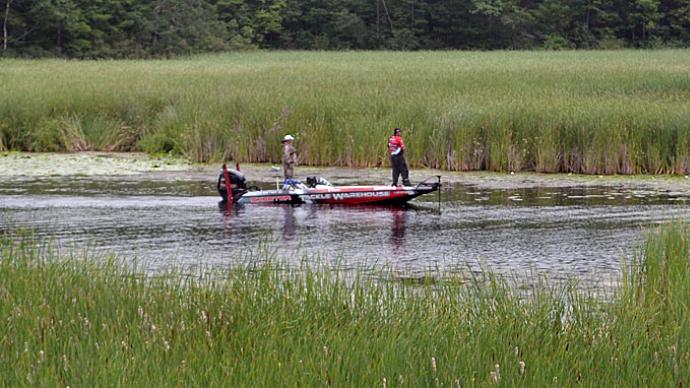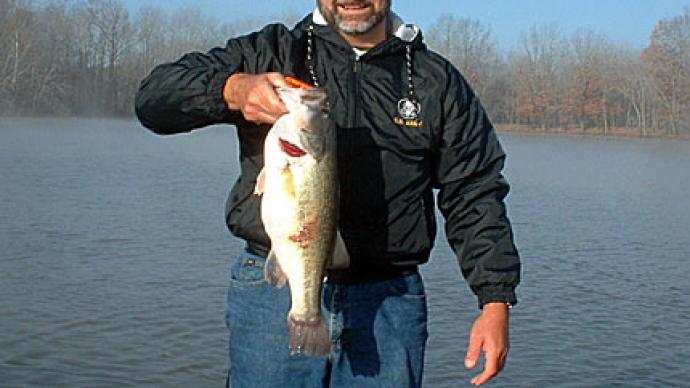
When I was a youngster I got to hear a Cajun fishing guide on Caddo Lake explain his philosophy of bass fishing. Simply put if the water was over the depth of his push pole, it was too deep. The lake is, in many parts, a typical bayou. Cypress islands dot the surface and narrow feeder channels wind through the forests into the main Cypress Bayou channel.
A bass, by nature, is a creature that fits the Cajuns game plan in that it thrives in shallow waterways and is at home in vegetation and cover.
The evolution of manmade lakes gave the black bass population considerable choices in habitat including deeper water haunts. Being very adaptive creatures, they populate several strata in those lakes.
Warmer water months are the times when bass will tend to be in shallower water for greater portions of their daily patterns.
I have always felt that bass have to overcome their instinct to move to deeper strata. Several things can influence these shifts away from the shallows. One of these is a migration of food into deeper water. The most important food source that can influence such a movement is shad. In warmer water, and particularly back-water areas, this can occur due to changes in water quality. The lack of oxygen in water affects bass, as well as shad, so poor quality water necessitates a shift into oxygen rich areas or places where wave action more readily places oxygen in the water.
A natural shift in habitat of bass usually occurs each day in that they move more shallow late in the day and during the night and then move out to deeper water with the increasing intensity of daylight.
This shift can be considerably altered if you consider that it in part occurs due to the influence of sunlight. For example, on a cloudy day bass may stay shallow all day. They may also stay shallow (if there is food and good water quality) if there is appropriate cover to offer shade. I can't emphasize the importance of brush, weeds, and water lilies in keeping bass shallow in a clear-water lake. Vegetation not only acts as an incubator for all the food chain, but it creates shade that draws bait and keeps a population of bass which are shaded from the sunlight.
Take the vegetation and cover out of a clear-water lake and your only option for shallow water fishing is indeed late afternoon, night, or early.
There is one other variable that keeps bass shallower for longer periods in a generally clear-water lake and that is the presence of stained water in the back of creeks or coves. These events occur when there is runoff from summer showers. Such stained, shallow areas attract baitfish and bass.
Summertime shallow water fishing with topwaters can be one of the most exciting ways to entice strikes. Working slush baits including those with tail spinners as well as chuggers, poppers, or Zaras make presentation an art form. An expert can "talk" a bass into striking by giving it a presentation that can't be resisted. While there are considerable color options in each of these types of baits, a basic black and white chugger and shad/chrome color in the others are necessities.
Buzzbaits and spinnerbaits have always been lethal weapons in shallow water when bass are in a chasing mood. Of course minnow-type baits such as Red Fins and Rogues are lethal on shallow water bass.
With all due respect to the Cajun fellow, shallow can be relative. You need to think shallow if fishing over hydrilla or some other vegetation in deeper water. When bass stratify shallow in relationship to the top of such underwater growth it presents a pattern similar to fishing a bank.
If there is vegetation then don't bypass the thick growth. Matted duckweed can be fished by working a floating lizard on its surface. Even if the mat is over deeper water the bass will be in the shade just under the mat and can sense the surface activity and burst through to take a lizard or scum frog fished on top.
Coontail and hydrilla can be worked with a weedless Slug-go-type bait with a swimming action that does everything through the thick stuff that you can do with a Red Fin or Rogue around the edge of growth or banks.
An amazing number of bass stay in shallow water in matted hydrilla beds during hot weather on Lake Fork. These fish are in water as shallow as four feet during the middle of 100-plus-degree days. They aren't prone to break the surface during the midday brightness to chase a lure, but watch out if a jig and craw worm dares to penetrate into their living room. It takes a bit of getting used to the part that you can catch such fish in bright sunshine and yet in shallow water, but it has worked in any lake that I have fished that offers good plant growth.
The benefits of vegetation for providing shade, oxygen, and a cooling habitat cannot be over stated.
Another interesting example of shallow water instinct of bass has become more and more appreciated by pros over the past 10 years. When manmade lakes are built in wooded areas there are often appreciable stands of large timber under the water. Many of the tops are barely exposed while others are just under the water. Bass are in 20 to 25 feet of water, but can often be found within these treetops at shallow water levels. The catch is again you must have shade so the submerged tree needs to have sufficiently large branches to permit the same type of shaded cover as a large submerged log provides next to a bank.
A number of folks who practice techniques for catching suspended fish work mid-range crankbaits. The game plan is to visualize that the bass are holding at a certain level down in the top of the cover and you want to work the bait along and through the thick stuff. You can work a worm in the same manner, but have to be cautious you don't let it fall through the layer where the bass are holding. A Slug-go- type lure with a light weight also can be bounced off the limbs yet easily kept at a given depth by using a countdown technique.
Another shallow haunt that folks tend to ignore is right in front of our eyes on most large takes. Most bridges are built with cross supports, which connect the pilings. Even if the bridge is in very deep water the cross-links are shallow-water shelves for fish including bass. Add in the fact that these are shaded areas and the pilings attract baitfish and you have a perfect holding place for bass. My first experience of fishing these cross-links helped me win a tournament. I would like to tell you that a great strategy and game plan worked out. However, I actually got under the bridge to get shade from the 100-degree day and had basically thrown in the towel. When all else fails, it's better to be lucky than good.
Most bass fishermen buzz through the bridge areas on Lake Fork leaving the crappie fishermen as the main folks working these bass. There are plenty of broken lines among the crappie folks to attest that big bass live under these bridges and on the shelves. Learn the layout of such cross-timbers by watching your transducer outline the depth of this structure. It will generally be the same on each set of pilings. To fish the cross-timber either pitch a worm or lizard on top, or work them parallel along the shelf. You can also use a Little George or spinnerbait and count it down to the depth of the cross-timber. If you let the bait get off the cross-timber and drop down the side very far, you are generally out of the strike zone.
Shallow-water bass fishing doesn't always mean an exercise limited to early, late, and bank fishing. Think through your options and you may be surprised at the variables you will have for shallow-water fishing on a given lake.




